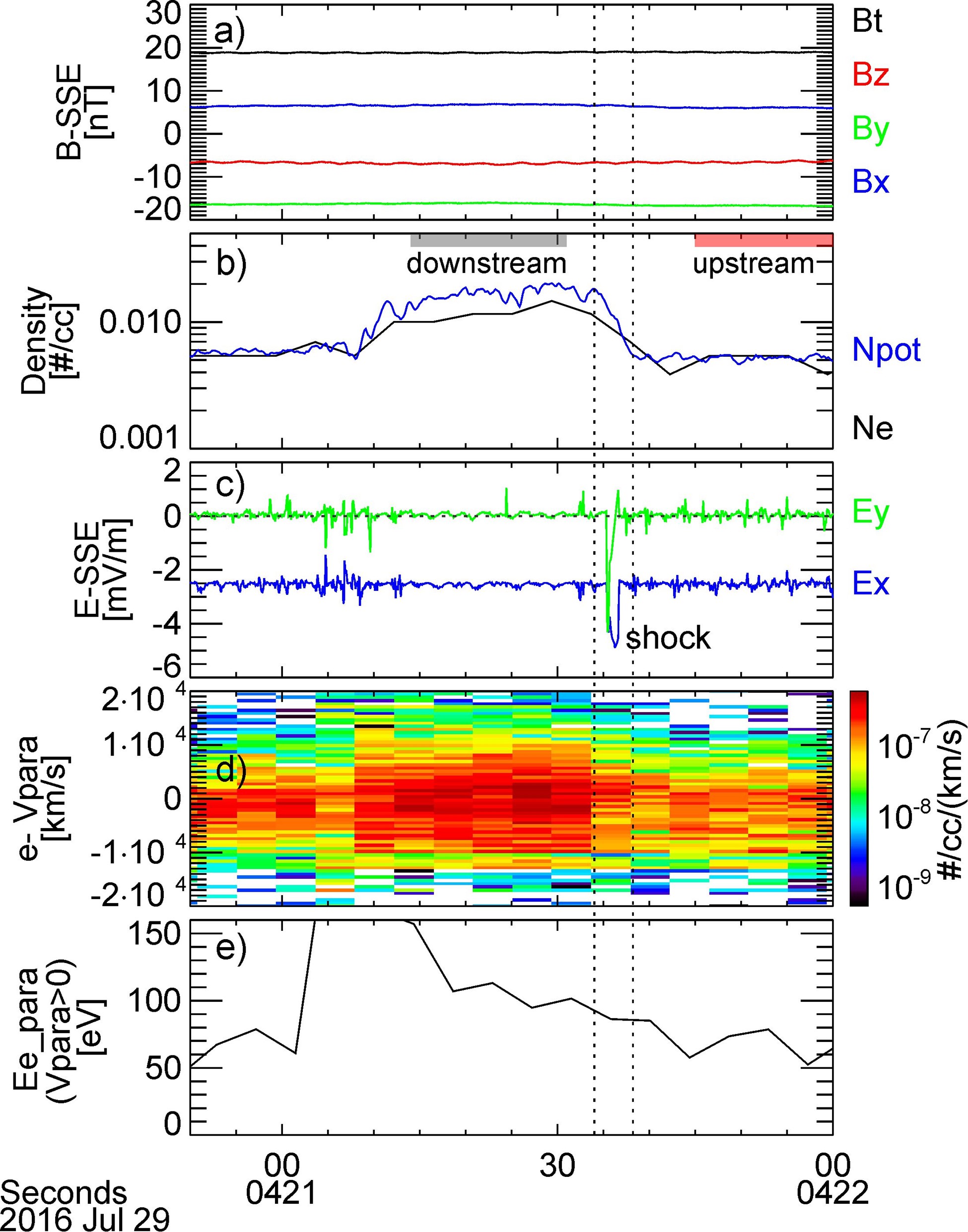2025 ARTEMIS SCIENCE NUGGETS
ARTEMIS Observations of Electrostatic Shocks inside the Lunar Wake
by Terry Liu and Xin An
Department of Earth, Planetary, and Space Sciences
University of California, Los Angeles
Introduction
When a supersonic plasma flow encounters an unmagnetized, airless body, the upstream-facing surface absorbs most of the plasma, creating a plasma void (or “wake”) on the downstream side. The lunar wake exemplifies this phenomenon and provides an accessible natural laboratory for studying plasma expansion into vacuum through in-situ spacecraft observations. The plasma refilling process depends critically on the interplanetary magnetic field (IMF). When the IMF is quasi-parallel to the wake boundary normal, kinetic processes along magnetic field lines dominate refilling dynamics. Solar wind electrons, being much more mobile than ions, rapidly penetrate the wake along field lines. This charge separation generates ambipolar electrostatic fields that accelerate ions into the wake and maintain quasi-neutrality. Recent particle-in-cell simulations reveal an intriguing consequence of this refilling process: when accelerated supersonic ion beams from opposite sides of the wake meet near the wake center, they can generate electrostatic shocks (An et al., 2025).
Results
Using data from the Acceleration, Reconnection, Turbulence and Electrodynamics of the Moon's Interaction with the Sun (ARTEMIS) spacecraft, we present the first observational evidence of these predicted electrostatic shocks. Event 1 captured the shock structure near the wake center, revealing an electrostatic solitary structure with an amplitude of ~2 mV/m and a spatial scale of ~50 local Debye lengths (Figure 1c). Notably, this structure occurred without accompanying magnetic field perturbations (Figure 1a), confirming its purely electrostatic nature. The shock generated a potential increase of ~50 V from upstream to downstream, which heated incoming electrons by ~50 eV in the parallel direction (Figure 1d) while simultaneously decelerating ions by ~60 km/s, leading to a density enhancement (Figure 1b). Event 2 likely represents a later evolutionary stage, captured several seconds after the electrostatic shocks expanded from their initial formation. This more evolved structure exhibited a dissipated morphology with an extended downstream region (~1000 km), merging ion populations, and intense electrostatic waves. Net electrostatic fields oriented from downstream to upstream on both sides created enhanced potentials and drove field-aligned electron heating in the downstream region. Both observations are in excellent agreement with predictions from PIC simulations by An et al. (2025).
| Figure 1. From top to bottom are (a) magnetic field in SSE, (b) electron density measured by ESA (black) and inferred from spacecraft potential (blue), (c) electric field in SSE (projected from the spacecraft spin plane, close to the equatorial plane; no Z component due to unreliable measurement along the spacecraft spin axis), (d) reduced 1-D electron velocity distribution function along the magnetic field by integrating over the perpendicular direction, (e) electron parallel energy from the parallel part of 1-D VDFs (v_∥>0). Vertical dotted lines indicate the density ramp. |
Discussion
Although electrostatic shocks have been predicted theoretically and reproduced in simulations and laboratory experiments, direct observations in space remain exceptionally rare, with confirmed detections occurring primarily in Earth’s auroral zones. This scarcity may be due to the characteristically small spatial scales of electrostatic shocks, which require impractically high-resolution plasma measurements to distinguish them from other electrostatic structures such as double layers. The lunar wake environment, however, offers a uniquely favorable observational window. The extremely low plasma density within the wake drastically expands characteristic plasma length scales, producing electron skin depths of tens of kilometers and Debye lengths of ~1 km. These expanded scales make the lunar wake as an ideal laboratory for resolving the electrostatic shocks and associated plasma dynamics with conventional spacecraft instrumentation. Beyond confirming theoretical predictions, our observations provide a reference for understanding similar plasma interactions around other airless celestial bodies throughout the solar system, where comparable wake structures and shock formation processes likely occur.
References
An, X., Angelopoulos, V., Liu, T. Z., Artemyev, A., Poppe, A. R., & Ma, D. (2025). Plasma Refilling of the Lunar Wake: Plasma‐Vacuum Interactions, Electrostatic Shocks, and Electromagnetic Instabilities. Journal of Geophysical Research: Space Physics, 130(7). https://doi.org/10.1029/2025ja034205Liu, T. Z., An, X., Angelopoulos, V., & Poppe, A. R. (2025). ARTEMIS Observations of Electrostatic Shocks inside the Lunar Wake. The Astrophysical Journal Letters, 990(2), L36. https://doi.org/10.3847/2041-8213/adfcc7
 Please send comments/suggestions to
Emmanuel Masongsong / emasongsong @ igpp.ucla.edu
Please send comments/suggestions to
Emmanuel Masongsong / emasongsong @ igpp.ucla.edu
